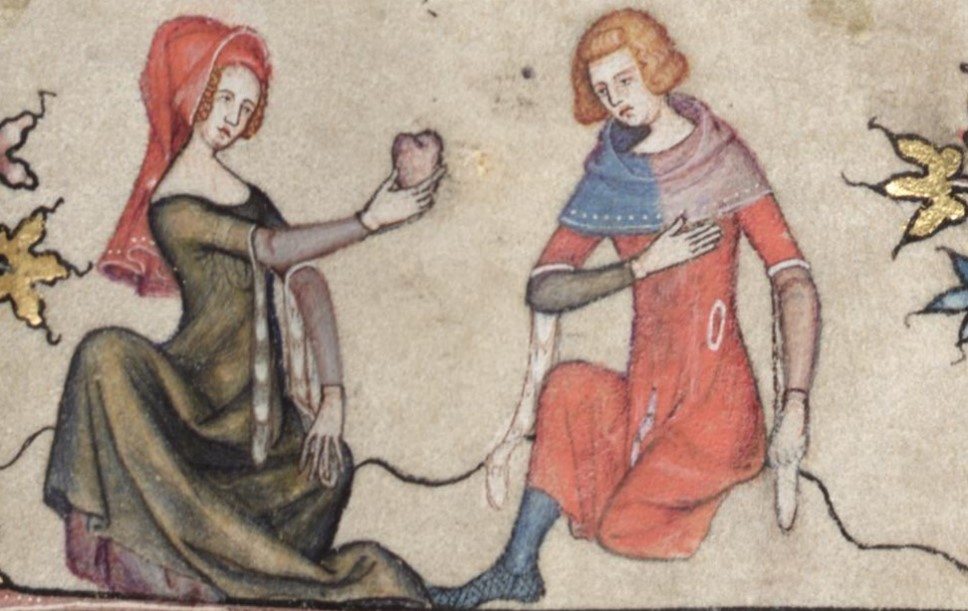Dr David Moses - Cor ad cor loquitur; modes and moments of medieval lightness

Dr David Moses, Assistant Head (6th Form) & Teacher of English: '"Last Christmas I gave you my heart": Cor ad cor loquitur; modes and moments of medieval lightness.'
Arriving at The Oratory has made me refocus on my major interest - the medieval. This is mainly because I have been thinking of the foundation of the school, and of the notion of Cor ad cor loquitur and its origins. The image of the couple above certainly suggests a ‘heart to heart’. Illuminated by gold leaves and highly medieval in their monochromatic manuscript, they are demonstrating the virtues of Courtly Love, though not suggesting that we should remove our essential organs! Rather, they show that we should trust others with our feelings, especially those we feel romantic love for. I have been worrying a question about medieval literature in which the idea of the heart keeps reoccuring. The heart, viewed as the seat of courage or determination, also suggests a vulnerability. It is an iconic symbol in medieval thought, life, literature and art. As I have thought more about defining a medieval psychology (they don’t have one, really, they have ‘sensibilities’) I have realised that the ‘feeling’ heart is, well, at the heart of their appreciations of Art, and of communicating feelings and understandings to others. You could say art and heart are inseparable.
Our English language is so removed from its roots that we need to think quite hard now about the origins and meanings (etymologies) of words. In contemplating the heart, the obvious things is that so many of our idioms attach our emotions to the heart and take the heart as the centre of all we learn and experience. We say that we learn things by heart, engage in heart – to – hearts (Cor ad cor loquitur), and that our hearts are fit to burst. To make a great commitment might be heartfelt, and when that commitment is broken by others we feel heartache. I am rereading Richard III at the moment: heartless! Richard needs a change of heart … or to take to heart his own failings.
At the heart of the matter is that we use the Norman French coeur a lot when it comes to love and war. It came into our language with the Norman invasion and changed our language forever. Knights have to have courage. Sir Gawain is cordial to ladies (cordis = Latin for Heart). Most interesting to me is the verb record. We register and learn ‘by heart’ things which we, well, inscribe upon our heart. And then we might keep those things at our self’s centre - at our core. In the picture above the ideal of courtliness, comes along with courtesy, from Norman French, because it is the behaviour of the royal court, from Latin cortem, accusative of cors "enclosed yard," but as you can see court and coeur become synonymous.
With some hot weather my mind has also turned to light, and specifically sunlight. When I was at university and researching for my doctorate in Medieval Literature I taught some post-graduate students. I remember showing them a picture of some medieval stained glass. The image was of the nativity. At the end of a beam of light was the infant Christ. My students were ‘wowed’ at the image but initially missed the point of the marked allegory. This was not merely an image but was super-charged with symbolism and was remarkable because of the glass onto which it was superimposed. The medieval mind was adept at interpreting everything symbolically; and glass was seen as being symbolically representative of The Blessed Virgin. Why? The light passes through it, without breaking it. It remains complete, and the light continues to pass through it to shine upon us and to illuminate our world. Glass was thought to be a miracle. It was associated with Mary because like her the light passes through but it retains its integrity and its essential nature. In the 1960s, Thomas Kuhn suggested that we cannot shake off our modernness to understand and to think in the manner that human beings in the past did. He said that we cannot think as they did because we know too much. I beg to differ, and suggest that while we may know a lot, we could work harder at understanding the sometimes complex, though also simply beautiful significance of the world around us, as our forefathers did. This thought comes as I begin to teach English Language A Level, and take our pupils back to the earliest written English, which tends to be about heroes and battles, spiritual journeys, and a new-found wonder at Christianity and its creation story. As much as possible I encourage students to set aside for a few moments the white noise of the modern to indulge a past illuminated with understandings which seem naïve, but which can be not merely sophisticated but upliftingly beautiful.
Why do I dwell on the idea of the heart, and of illumination? Medieval artists and poets were aware that human life is full of chaos and suffering. Roger Scruton said that beauty and the aesthetic have fallen into disrepute and described the remedy as ‘beauty.’ ‘The beautiful work of art brings consolation in sorrow and affirmation in joy. It shows human life to be worthwhile.’ Indeed, the medieval audience were supposed to take delight (delectatio) in such images and ideas. They interacted with them in chapel and castle, manor and monastery, better to measure themselves against what were often beautiful - if unattainable - ideals.

